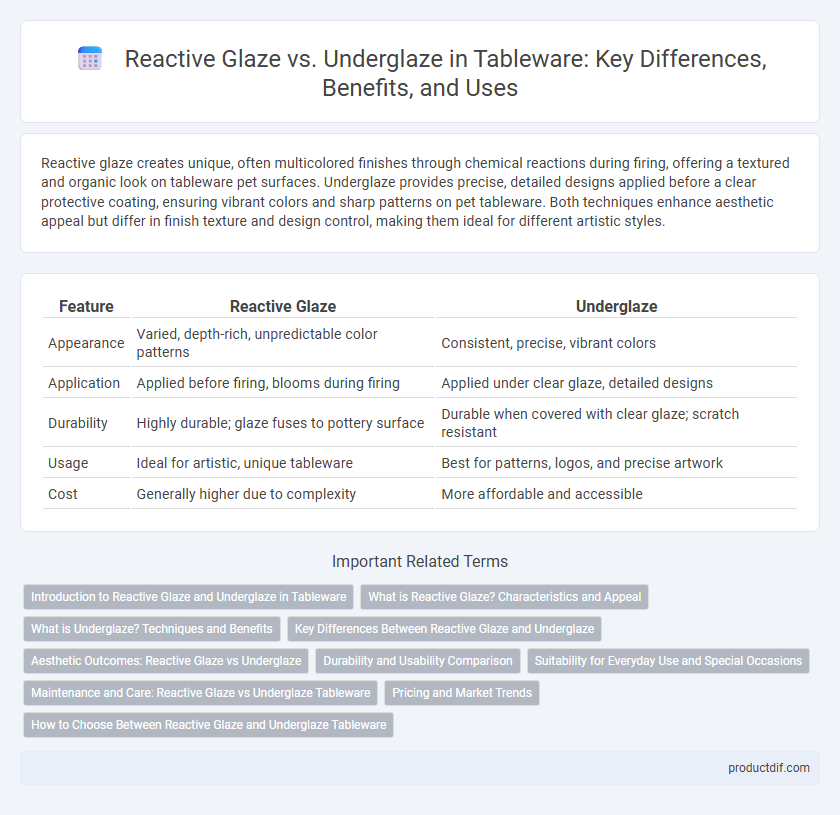Reactive glaze creates unique, often multicolored finishes through chemical reactions during firing, offering a textured and organic look on tableware pet surfaces. Underglaze provides precise, detailed designs applied before a clear protective coating, ensuring vibrant colors and sharp patterns on pet tableware. Both techniques enhance aesthetic appeal but differ in finish texture and design control, making them ideal for different artistic styles.
Table of Comparison
| Feature | Reactive Glaze | Underglaze |
|---|---|---|
| Appearance | Varied, depth-rich, unpredictable color patterns | Consistent, precise, vibrant colors |
| Application | Applied before firing, blooms during firing | Applied under clear glaze, detailed designs |
| Durability | Highly durable; glaze fuses to pottery surface | Durable when covered with clear glaze; scratch resistant |
| Usage | Ideal for artistic, unique tableware | Best for patterns, logos, and precise artwork |
| Cost | Generally higher due to complexity | More affordable and accessible |
Introduction to Reactive Glaze and Underglaze in Tableware
Reactive glaze in tableware creates unpredictable, variegated surface patterns through chemical reactions during firing, offering a unique, textured finish favored for artisanal ceramics. Underglaze involves applying colored decoration beneath a transparent glaze, ensuring durable, detailed designs that resist fading and wear over time. Both techniques significantly influence the aesthetic and functional qualities of ceramic tableware, with reactive glaze emphasizing organic variation and underglaze prioritizing precision and color longevity.
What is Reactive Glaze? Characteristics and Appeal
Reactive glaze is a type of ceramic glaze known for its unpredictable, variegated surface textures and colors that develop through chemical reactions during firing. It often features complex patterns, metallic sheens, and depth in color, making each piece unique and highly sought after in artisanal tableware. The appeal of reactive glaze lies in its organic, dynamic finish that enhances the tactile and visual experience of functional ceramics.
What is Underglaze? Techniques and Benefits
Underglaze is a ceramic decoration technique involving the application of pigments or designs onto pottery before the final clear glaze is applied and fired, resulting in durable, vivid patterns. This method allows for precise detailing and a wide color palette, as the pigments remain stable under high kiln temperatures. Underglaze offers benefits such as resistance to wear, enhanced design longevity, and compatibility with various ceramic bodies, making it ideal for intricate tableware decorations.
Key Differences Between Reactive Glaze and Underglaze
Reactive glaze creates unique, unpredictable patterns through chemical reactions during firing, resulting in textured and variegated finishes that vary with each piece. Underglaze offers precise, stable color application beneath a clear glaze, allowing detailed designs and consistent results without chemical alteration during firing. The key difference lies in reactive glaze's dynamic surface effects versus underglaze's controlled, predictable decoration method.
Aesthetic Outcomes: Reactive Glaze vs Underglaze
Reactive glaze produces unpredictable, organic patterns and rich textures that create unique, one-of-a-kind finishes on tableware, often displaying variegated color blends and depth. Underglaze offers precise, controlled designs with crisp lines and vibrant colors that remain protected under a clear topcoat, ideal for detailed artwork and repeatable patterns. Both techniques enhance aesthetic appeal, with reactive glaze emphasizing natural variation and underglaze focusing on detailed imagery and consistency.
Durability and Usability Comparison
Reactive glaze offers a unique, textured finish that enhances durability by creating a thicker, more resilient surface resistant to scratches and chipping. Underglaze provides detailed, vibrant patterns beneath a clear protective coat, improving usability by ensuring designs remain intact through frequent washing and heavy use. Both techniques contribute to long-lasting tableware, but reactive glaze excels in withstanding physical wear while underglaze maintains decorative integrity over time.
Suitability for Everyday Use and Special Occasions
Reactive glaze offers a unique, variegated finish that enhances tableware's aesthetic appeal, making it ideal for special occasions where visual impact is desired. Underglaze provides a durable, chip-resistant coating that withstands daily wear and frequent washing, ensuring practical suitability for everyday use. Both finishes balance beauty and functionality, with reactive glaze preferred for artistic expression and underglaze favored for consistent durability.
Maintenance and Care: Reactive Glaze vs Underglaze Tableware
Reactive glaze tableware requires gentle hand washing to preserve its unique, variegated surface patterns, as harsh detergents and abrasive scrubbing can damage the finish. Underglaze tableware offers more durability and is often dishwasher-safe, thanks to the design being sealed beneath a clear glaze, which resists fading and wear. Proper maintenance of reactive glaze preserves its aesthetic appeal, while underglaze provides a more practical, low-maintenance option for everyday use.
Pricing and Market Trends
Reactive glaze tableware commands higher prices due to its unique, variegated finishes that appeal to premium market segments, while underglaze pieces are typically more affordable, targeting mass-market consumers. Market trends indicate a growing demand for artisanal, one-of-a-kind reactive glaze ceramics driven by consumer interest in handmade aesthetics and sustainable production. In contrast, underglaze remains popular in commercial and casual dining settings where uniformity and cost-effectiveness are prioritized.
How to Choose Between Reactive Glaze and Underglaze Tableware
Choosing between reactive glaze and underglaze tableware depends on the desired aesthetic and durability; reactive glaze offers unique, unpredictable patterns and a glossy finish that enhances texture, while underglaze provides precise, detailed designs with vivid colors that resist fading. Consider the tableware's intended use, as reactive glaze surfaces are often more resistant to scratching and staining, making them suitable for everyday use, whereas underglaze pieces excel in decorative appeal for special occasions. Evaluate maintenance requirements, since reactive glaze may require gentle cleaning to preserve its finish, whereas underglaze items typically withstand dishwasher cycles without compromising the design quality.
Reactive Glaze vs Underglaze Infographic

 productdif.com
productdif.com